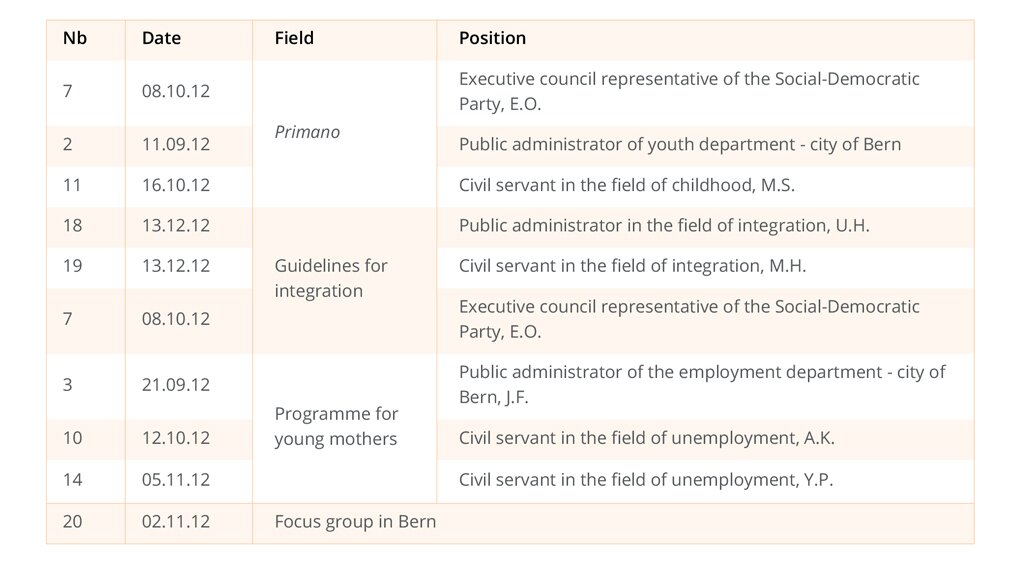Bern
Bern – Conclusions
Bibliography
- Baker, A. J. L., Piotrkowski, C. S. & Brooks-Gunn, J. (1999) “The Home Instruction Programme for Preschool Youngsters (HIPPY).” The Future of Children, 9, 1, 1 April 1, pp. 116–133.
- Cattacin, S. (1996) “Die Transformation Des Schweizer Sozialstaates. Überlegungen Zu Seiner Entwicklungslogik.” Swiss Political Science Review, 2, 1, 1–14.
- Cattacin, S., Gianni, M., Mänz, M., & Tattini V. (2002) Retour au travail!: le workfare comme instrument de réforme. Editions Universitaires Fribourg. Res Socialis. Fribourg.
- Chambon, J.-L., David, A. & Devevey, J.M. (1982) Les innovations sociales. Paris: Presses universitaires de France.
- Clarke, H. & Hughes, N. (2010) “Introduction: Family Minded Policy and Whole Family Practice – Developing a Critical Research Framework.” Social Policy and Society, 9, 4, 3 September 3, pp. 527–531.
- Currie, J. & Thomas, D. (1993) “Does Head Start Make a Difference?” Working Paper 4406. National Bureau of Economic Research. http://www.nber.org/papers/w4406.
- Demailly, L. & Verdière J. (1999) “Les Limites de La Coopération Dans Les Partenariats En ZEP.” Ville, Ecole, Intégration.
- Esping-Andersen, G. (2009) The Incomplete Revolution: Adapting to Women’s New Roles. Cambridge, UK/Malden, MA: Polity Press.
- Evers, A. & Guillemard A.M. (2012) Social Policy and Citizenship : the Changing Landscape. New York: Oxford University Press.
- Giddens, A. (1998) The Third Way: the Renewal of Social Democracy. Malden, Cambridge, MA: Polity Press.
- Gilbert, N. & Gilbert B. (1989) The Enabling State Modern Welfare Capitalism in America. New York: Oxford University Press.
- Hernanz M., , Franck Malherbet V. & Pellizzari, M. (2004) “Take-up of Welfare Benefits in OECD Countries: a Review of the Evidence.” http://www.oecd.org/dataoecd/60/30/30901173.pdf.
- Morris, K., Hughes, N., Clarke, H., Tew, J. & Mason, P. (2008) Think Family a Literature Review of Whole Family Approaches. London: Social Exclusion Task Force.
- Moulaert, F., Swyngedouw, E., Martinelli, F. & Gonzalez, S. (2010) Can Neighbourhoods Save the City? Community Development and Social Innovation. Taylor & Francis.
- Palier, B. (2005) “Vers un État d’investissement social.” Informations sociales, 128, 8, 1 December, pp. 118–128.
- Sanders, M. R. (2008) “Triple P-Positive Parenting Programme as a Public Health Approach to Strengthening Parenting.” Journal of Family Psychology: JFP: Journal of the Division of Family Psychology of the American Psychological Association (Division 43), 22, 4, August, pp. 506–517.
- Scholten, P. (2006) Social Return on Investment: a Guide to SROI Analysis. Amsterdam: Lenthe.
- Schönenberger, S., & D’Amato, G. (2009) “Das Integrationsleitbild Der Stadt Bern Neu Überdacht”. Forum suisse pour l’étude des migrations et de la population.
- Strahm, R. H. (2010) Warum Wir so Reich Sind: Wirtschaftsbuch Schweiz. 2., erw. und aktualisierte Aufl. Bern: hep, der Bildungsverlag.
- Vogel, H. (2006) “Gut Vernetzt, Aber Schwach Verankert.” Terra Cognita, 10, September, pp. 82–85.

